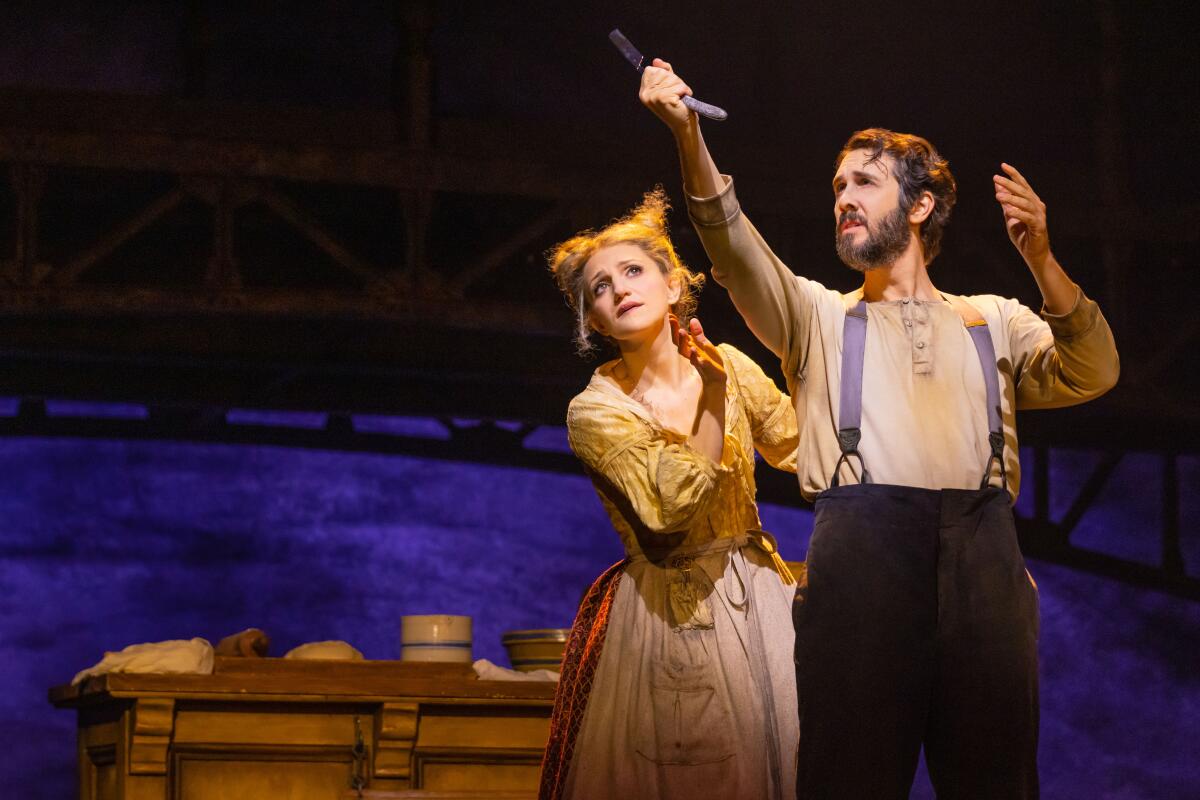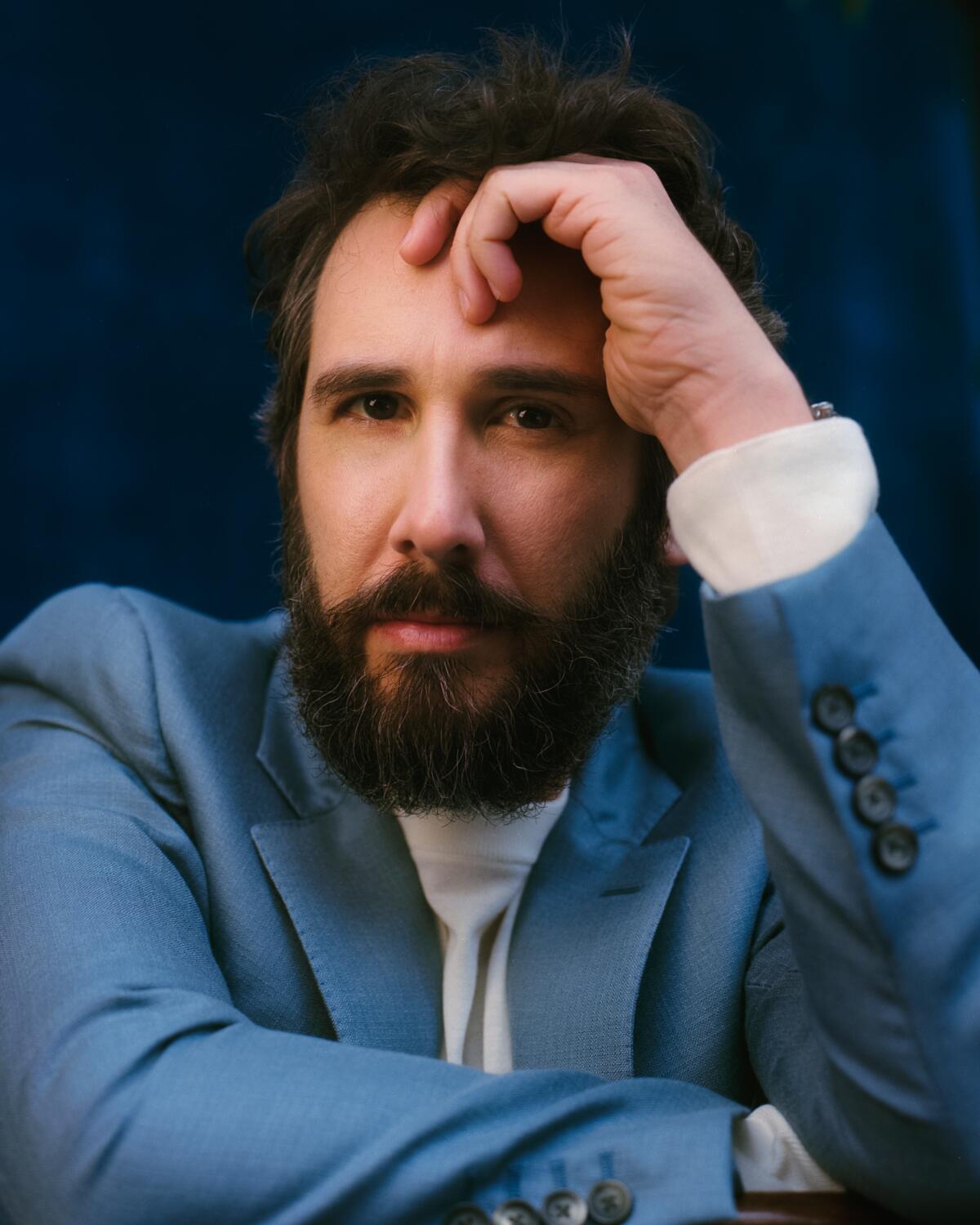The biggest entertainment stories
Get our big stories about Hollywood, film, television, music, arts, culture and more right in your inbox as soon as they publish.
You may occasionally receive promotional content from the Los Angeles Times.

NEW YORK — Broadway has long welcomed celebrity interlopers, but it’s hard to think of anyone with the star power of recording artist Josh Groban who has been as wholly embraced by the theater community.
He may have sold more than 26 million albums and performed in the most hallowed concert halls on the planet, but when he’s cast in a musical, he becomes just another hardworking member of the company — albeit one with screaming fans in the audience and autograph hounds outside the stage door.
Groban was nominated for a Tony Award for his Broadway debut performance in “Natasha, Pierre & the Great Comet of 1812,” playing the corpulent, alcoholic Pierre in Dave Malloy’s inventive musical spun from a slice of Leo Tolstoy’s “War and Peace.” Donning a fat suit and an accordion that he learned to play just for the role, Groban dove into his character so completely that he refused to clean up Pierre’s scraggly beard even (to his management team’s chagrin) when making holiday media appearances during the Broadway run.
In the wake of Stephen Sondheim’s death at 91, singer Josh Groban revisits his long relationship with and admiration for the beloved composer’s legacy.
His latest theatrical challenge is his most fearsome yet. Groban stars in the new production of Stephen Sondheim and Hugh Wheeler’s “Sweeney Todd: The Demon Barber of Fleet Street,” playing the murderous title role opposite Annaleigh Ashford’s Mrs. Lovett, Sweeney’s partner in crime who comes up with a culinary use for all those customers sliding to their gurgling deaths after a shave and a haircut. (Both actors are nominated for Tony Awards for their lead performances.)
Talk about playing against type. If Groban were interested in making Broadway an extension of his singing career, he might have chosen another role from the Sondheim canon: George from “Sunday in the Park With George.” Playing a painter whose obsessive focus on his work yields magnificent art but significant heartbreak would have allowed Groban to radiate the dashing melancholy that has made him one of the leading contemporary interpreters of the American songbook.
The irony of playing Sweeney is that the character’s most lyrical singing tends to happen in the most macabre of circumstances. The more homicidal the action, the more beautiful the melody.
“I really think that is what Sondheim intended,” Groban said. “It is not written to be sung ugly. The line that Sondheim wrote is romantic, aria-esque.”
Groban was seated in a back booth at a popular theater restaurant near the Lunt-Fontanne Theatre, where this revival of “Sweeney Todd,” directed by Thomas Kail, is playing to some of the most enthusiastic audiences since “Hamilton” (also helmed by Kail) opened. His ear was anxiously attuned to the room’s ambient noise, but the din fortunately subsided, allowing him to proceed with his preferred mode of conversation, the tête-à-tête.
For a big star, Groban is refreshingly free of pretense. He has an instinctual appreciation of the artisan nature of being an artist. He shows up for work, onstage or off, prepared to do his best. There’s nothing dilettantish about his detail-oriented attitude. A professional’s professional, he enjoys talking shop as a surgeon might enjoy discussing the intricacies of a new heart procedure or a mechanic the engineering dynamics of an electric vehicle.
Born and raised in Los Angeles, Groban was exposed to the arts from a young age. His mother was a visual arts teacher and his father was a jazz trumpeter before becoming an executive recruiter. Family outings to the Music Center and other Los Angeles performing arts meccas were routine. “Cats” and “Carousel” left strong early impressions, as did the magic of Cirque du Soleil at the Santa Monica Pier. His first encounter with “Sweeney Todd” was via East West Players’ 1994 production directed by Tim Dang — an experience that excited a lifelong love affair with the musical.

But his greatest debt is to the school music and theater programs that helped him find his voice — as a person even more than a singer.
“Growing up and being a very shy kid, I was having a hard time communicating,” he said. “Singing was my strongest way of communicating. And that’s why I’m such a proponent of arts education in schools, because it saved me. Having that choir teacher and those little cabaret shows in junior high school took me from being that introverted kid that might have gone down some self-destructive paths to somebody who knew how to get what was inside, out to people.”
The last few years have been big ones for Josh Groban, Musical Theater Nut.
A proud graduate of Los Angeles County High School for the Arts, Groban started his Find Your Light Foundation in 2011 to support arts programs nationwide. He knows that arts education isn’t a luxury, but a potential lifeline for students struggling to find their way.
“I was diagnosed with ADD when I was in 9th grade after a couple of years of not knowing why I couldn’t keep up,” he said. “At that point, there wasn’t really any understanding of it other than your son’s not paying attention, your son’s not raising his hand ever, he’s looking out the window. He’s just not trying hard enough. He’s just not smart enough. So there was a huge amount of self-doubt, self-criticism and shame that came from not knowing why I wasn’t doing what everyone else was doing in the class.”
Paying attention turned out not to be an issue in the music room, and connecting with other kids was no problem when rehearsing a show. “These experiences allowed me to channel the same focus into other areas of my education, and that confidence seeps into every facet of education,” he said.
Groban was accepted to Carnegie Mellon University’s prestigious music theater program, but his burgeoning singing career didn’t allow him to matriculate for long. David Foster, the storied Canadian record producer and musician, identified in Groban a rare talent that could potentially bring the pop and classical worlds closer together.
“When I first got started at 17, I had a hard time figuring out which category we were shooting for,” said Groban. “David Foster just liked my singing. He was the first person to say to me, ‘Don’t worry about how people are going to write about it. Don’t worry about what category you’re going to find yourself in. Just sing from the heart. Find songs you love. And you will find your audience, hopefully. And if you don’t, good luck going back to school and have a nice life.’ And that would have been fine with me, because I was so happy to be at Carnegie Mellon.”

He acknowledged that the music industry can be rough. “Being a young and sensitive kid and getting half praise, half criticism in both ears, you don’t know which way is up,” he said. “And you do read all the stuff about where people are trying to put you. And then with things like awards, there are actually very specific categories. So one day I was finding myself on a list with someone like Plácido Domingo and another I was finding myself on a list with Justin Timberlake. And I didn’t fit in either place. Yeah, that could be really frustrating and lonely to feel like, even within this music community that was lifting me at that point, I was finding myself not really welcome in any part of it. But that wound up being good news for me because it allowed me to write my own playbook.”
Musical theater was Groban’s original plan, so Broadway in some ways represents a return rather than a departure. His majestic baritone has long attracted the interest of theater royals. Barbara Cook, in her introduction to Groban on her 2006 concert album, “Barbara Cook at the Met,” said that he has “one of the most beautiful, natural voices that’s come around in a long, long time.” His gorgeous recordings of show tunes — including “All I Ask of You” with Kelly Clarkson on his “Stages” album and “The Impossible Dream” on “Harmony” — have only whetted Broadway hopes.
This revival of “Sweeney Todd” was in discussion before the pandemic, when Sondheim was still alive. “Josh called me in 2019 and asked if I was interested in talking about doing the show together,” Kail recalled via email. “I was instantly excited about creating a Sweeney with him that embraced the depth of feeling and humanity Josh brings to his storytelling. We both wanted to tell a story of how and why Benjamin Barker became Sweeney Todd.”
The idea was to do a production at full scale, using Jonathan Tunick’s original 26-piece orchestrations. The grandness of this Grand Guignol tale was to be preserved, but with a close-up intimacy that could shine a light into the inner workings of the characters.
“It was exciting to us to see whether there was a way to keep all of the melodrama, for lack of a better word, but find some kind of common thread of humanity,” Groban said. “To find that connective tissue that doesn’t necessarily happen when the monster just walks into the room.”
Merle Dandridge, Montego Glover, Annaleigh Ashford, Katie Rose Clarke and Britney Coleman, each starring in a Stephen Sondheim musical, reflect on the texts of the late theater legend.
After being unjustly convicted and sent to prison in Australia, Benjamin Barker returns to England as Sweeney Todd to exact revenge not only on the wicked Judge Turpin who upended his life, but on a society that could permit such iniquity. Hal Prince, in his original 1979 production, made Sweeney an avenger of Victorian era industrialization. Groban wanted to understand him, first and foremost, as a man.
“From the very beginning, we wanted to chip away at who Benjamin Barker was,” he said. “This was a person who did not kill before this disastrous thing that was done to him. He was the victim. He got sent away because the judge coveted his child and his wife. Maybe prison was a place where killing had to happen, where the facade had to go away. Maybe there was a nucleus in him that was always brewing. But I like to think about the person who was a loving husband, the person who made his baby daughter laugh, and had friends and understood what it took to be a charming small-business owner.”
The point isn’t to sentimentalize Sweeney, a willing accomplice in Mrs. Lovett’s scheme of stuffing the pies in her moldy shop with human flesh to improve sales, but to track the path of his murderous transformation. “We wanted the monstrous behavior to be earned on a human level, which then changes how the ending feels,” Groban explained.
Pasadena Playhouse wins the Tony Award for regional theater excellence, becoming only the second Los Angeles institution to earn the honor and continuing its triumphant streak after years of turbulence.
Of course, the musical is often outrageously hilarious. Nowhere more so than in Sweeney and Mrs. Lovett’s demonically funny “A Little Priest,” which closes the first act with an imagined Baskin-Robbins assortment of cannibal flavors for her pie shop.
If singing is a God-given superpower, comedy is a natural strength for Groban. He joked about taking on the role of a maniac barber: “I’m very much a pacifist. People think I’m Canadian for a reason.” And he’s long been game to send up his own public image, whether it’s guest appearances on “Glee” or some naughty banter with Miss Piggy on “The Muppets.” “Because my music has always been serious as a heart attack, I don’t take myself seriously even if I take my music seriously,” he explained.
Sondheim impressed upon Groban the importance of the show’s humor in their conversations on the revival. Message received. The production is perhaps most spontaneously alive in those moments when Groban is playing off Ashford’s Mrs. Lovett, whose comic attack has drawn comparisons to Angela Lansbury’s cockeyed Cockney version of the role.
Groban had nothing but praise for his co-star, who won a Tony in 2015 for her performance in the Moss Hart-George S. Kaufman comedy “You Can’t Take It With You” and received rapturous acclaim for her role in the 2017 revival of “Sunday in the Park With George” that starred Jake Gyllenhaal.
“Annaleigh has more tools in her tool belt than I have,” he said. “It’s been six years since I’ve been on a Broadway stage. We both have been away from Broadway for a minute, but she’s done so many productions and comes from a world of physical comedy and clowning. To be able to watch her and bounce off her — so much of acting is reacting. Tommy Kail allowed us the freedom to have fun during the rehearsals, and then he’d rein us in. But we’ve never lost the idea of that playful spirit.”
Ben Platt embraces the ‘discomfort and anxiety’ of ‘Parade,’ about the 1913 trial and subsequent lynching of Jewish American Leo Frank in Georgia.
Audience excitement at the Lunt-Fontanne is at the level of, well, a Josh Groban concert. “Josh’s previous body of work is a promise to the audience that he has the goods every time he steps on stage,” Kail said. “This certainly builds anticipation as folks step into the theater, and when he arrives in the opening number as Sweeney, he shows us immediately that he is going to deliver once again. It’s a thrill to behold.”
But Groban insisted that the squeals and shrieks are not for him alone. “Our cast is so stacked with talent,” he said. “Every single performer on that stage is a Swiss Army knife of talents. And I feel privileged to be up there with them.”
Performing in Sondheim is the ultimate dream. “I have always felt a vocal kinship with his work,” Groban said. “Ever since I was 13, 14, I was singing his stuff in my bedroom. There are lots of brilliant composers that I can sing, but sometimes it feels like I’m faking it. It sounds OK, but it’s not right. But with Sondheim, the head, the heart and the voice are a straight line.”
The biggest entertainment stories
Get our big stories about Hollywood, film, television, music, arts, culture and more right in your inbox as soon as they publish.
You may occasionally receive promotional content from the Los Angeles Times.